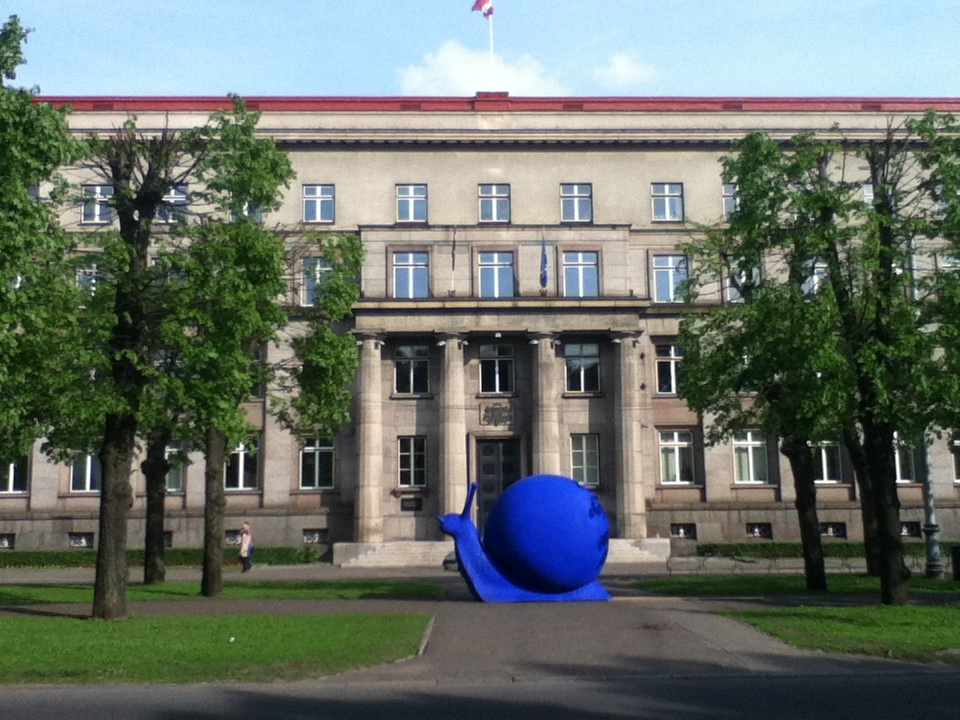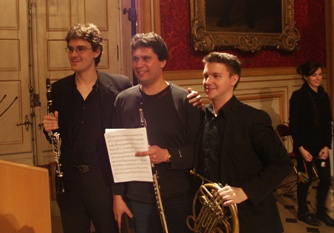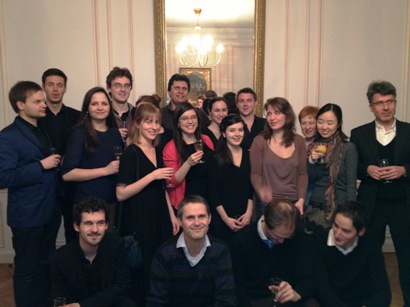Basic formulations and methodology
July 16, 2014
July 16, 2014

June 26, 2014
Paulo Ravecca, who received a Sylff fellowship while at York University and was awarded a Sylff Research Abroad grant in 2011, visited the Tokyo Foundation on May 27, 2014. Ravecca was invited to Japan by the Embassy of Ecuador to work on a book with another scholar.
Ravecca is currently enrolled in a PhD program at York University and is writing his dissertation on the “politics of political science” in Chile and Uruguay. It focuses on the trajectory of political science as a discipline in the two countries, with references to Argentina and Brazil as well. Ravecca shows that the changes in political science in these Latin American countries are a product of power relations at different levels.
Ravecca’s analysis is expected to shed new light on the world of political science. We at the Tokyo Foundation wish him all the best with his dissertation.
June 19, 2014
June 19, 2014

June 18, 2014
On May 19, 2014, the University of Latvia organized a conference featuring nine Sylff fellows on the topic of “World in Change: From Consumption to Sustainability, from Competition to Collaboration, from Hierarchy to Networks, from Being Good to Doing Good.” The university joined the Sylff community in 2002.
The opening ceremony featured remarks by Rector Marcis Auzins, who reflected on the impact of the Sylff program at the university; Professor Ina Druviete, the former Latvian minister of education and science; Nippon Foundation Chairman Yohei Sasakawa, who described his work towards the eradication of leprosy and the discrimination that comes with ; and Tokyo Foundation Director for Leadership Development Takashi Suzuki, who encouraged Sylff fellows to take the initiative by referring to Latvia’s rapid economic recovery after the Lehman crisis.
Following the opening ceremony, nine Sylff fellows made presentations on the conference theme. They included six fellows from University of Latvia, two from the University of Leipzig, and one from Jagiellonian University. All presentations are available in PowerPoint at the university’s website.
The Tokyo Foundation thanks Ilona Baumane, a Sylff fellow at the University of Latvia, for organizing the conference and enabling our participation.

June 9, 2014
Sylff fellow (2005, University of Music and Performing Arts Vienna) and conductor/pianist Jimmy Chiang has performed in venues around Japan as the resident conductor of the Vienna Boys’ Choir.
He and the choir’s “Haydn Team” went on an extensive tour of Japan from late April to mid-June. As in many countries, the Vienna Boys’ Choir is extremely popular in Japan and Jimmy’s Choir performed at many of the most prestigious concert halls in the country, including Suntory Hall and Tokyo Opera City.
“I have been conducting mainly operas and symphonies, so I was surprised when I was approached to conduct the Vienna Boys’ Choir last year. I think I made a positive impact in the short time I ‘ve been with the choir, and I have enjoyed the experience enormously.”
Jimmy has endeavored to make performances more entertaining and engaging. Under Jimmy’s guidance, the boys not only sing but also perform musical instruments, including piano and percussion, and sometimes surprise the audience by appearing on the balcony, giving the impression of yodeling from mountain to mountain. Audiences in Japan have been thrilled. Jimmy’s experience in opera has enabled such dramatic and creative forms of expression, which represent a break from traditional, orthodox choir singing.
Jimmy’s extensive experience and skills have been effective in leading the choir from day one. “I have been pushing the boys to be more professional by showing them my own professionalism as a musician.” Jimmy is a father of two boys and says that being a father has helped him to be strict and loving at the same time.
As a message to young Sylff musicians, he had this advice: “Be honest. Be honest with your music. Be honest with your audience. It’s a challenge building a musical career, but don’t compromise. Try not to lose your originality, and always keep in mind what you set out to do in the beginning.”
Jimmy Chiang
After receiving a Sylff fellowship in 2005 at the University of Music and Performing Arts Vienna, where he studied orchestral conducting, chorus conducting, and piano, he was awarded the First Prize in the renowned Lovro von Matacic International Competition for Young Conductors in 2007. His career since has taken him to the most distinguished stages around the world. As a Sylff fellow, he has also participated in charity concerts with other fellows at the University of Music and Performing Arts Vienna. Besides his active performing schedule, Jimmy also devotes himself to music education, serving as artistic adviser to the Hong Kong Children’s Symphony and as tour leader and performer since 2011 of children’s opera productions of Kinderoper Papageno, seen by over 15,000 children in the German speaking world.
Jimmy's official website: www.jimmychiang.com
May 31, 2014


May 29, 2014
Roger Cliff, who received a Sylff fellowship in 1991 while attending the Woodrow Wilson School of Public and International Affairs at Princeton University, visited the Tokyo Foundation on April 4 to participate in a dialogue on East Asian security. The day-long workshop on extended deterrence in East Asia, organized by the Tokyo Foundation, and the Atlantic Council, was attended by security experts from Japan, the United States, and South Korea.
Roger is a nonresident senior fellow at the Atlantic Council’s Brent Scowcroft Center on International Security, where he is engaged in the Center’s Asia Security Initiative as a specialist on East Asian security issues. The Brent Scowcroft Center is the Atlantic Council’s flagship international security program, analyzing how global trends and emerging security challenges will impact the United States, its allies, and global partners.
It was a great joy to see a Sylff fellow working with the Tokyo Foundation’s research fellows. He noted that he regularly checks the Foundation’s website and email newsletter and finds the information helpful, especially the articles by Tsuneo Watanabe, the Foundation’s director of foreign and security policy research and senior fellow.
Sylff was endowed at Princeton University in 1989, and Roger was one of the early fellows at the university. He has focused his research on East Asian security and US foreign policy toward the region and is now an expert producing cutting-edge analyses and developing strategies for how the United States can best work with like-minded countries to shape the future. Read his articles and comments here.
================================================
The Tokyo Foundation is eager to keep track of the activities of Sylff fellows in various fields, so please keep us posted. Also, be sure to keep your contact information up-to-date. This is essential in enabling us to provide you the latest information on additional support programs and other initiatives.
May 26, 2014

May 12, 2014
By null
The seventh Sylff chamber music program, “New York-Paris-Vienna,” was held recently in Paris with a grant from the Tokyo Foundation. Here, Paris steering committee member Gretchen Amussen introduces some of the enthusiastic comments by the participating fellows and professors.
* * *
From January 16 to 24, 2014, the Paris Conservatoire hosted eight Sylff musicians from Vienna’s University of Music and Performing Arts and New York’s Juilliard School, who joined forces with four professors and six Paris Sylff fellows for a week of chamber music, culminating in a magnificent concert in the Invalides Army Museum’s historic seventeenth-century Grand Salon. The musicians, representing eight nationalities, performed works by Tomasi, Ravel, Jolivet, De Falla, Villa-Lobos, and Mozart.
“Playing music with new people is always a challenge,” said French fellow and flutist Mathilde Calderini of the experience, “because first you have to ‘find’ each other. But in the end it’s worth it!”
For French fellows Lomic Lamouroux and Carl-Emmanuel Fisbach, who participated in last year’s Viennese encounter, as well as pianist Antoine Alerini, who had gone to New York several years ago, being the hosts meant taking responsibility for sharing French culture. For Lomic, “The human aspect is essential, which is why I wanted to spend time with other fellows so they could better understand our country, our art, and who we are, much as had been the case for me when I went to Vienna.” In fact, for all involved, the cultural dimension proved as important as the music making.
For Juilliard’s Francesca dePasquale, “It’s one thing to speak about the French sound for French composers and completely another to be in France, see the incredible architecture, art, museums, and learn about the kind of sound here. For me, this was very valuable as an artist.” Vienna’s Georgina Oakes agreed, saying “I can’t get over the beauty of the city, which I’m sure will continue to inspire my artistry.”
The cultural aspect of the week got off to a vibrant start with an afternoon tour of the city, followed by dinner at the Auberge des Pyrénées-Cévennes. Traditional French cooking from the Southwest and from Lyon was featured, allowing for new culinary discoveries. Georgina Oakes, doubtless the most adventurous, chose a dish featuring pig’s feet, which she joyfully shared with those sitting close to her. For Georgina, “tasting” a culture seemed as important as hearing a new language and visiting historic monuments.
The project began weeks earlier with the sending of hard-to-find scores and parts to the visiting fellows. Upon their arrival, complex rehearsal schedules were distributed, and students were taken on a tour of the Invalides Army Museum. Of particular interest to the visitors was Paris’s system of reserving time and space for personal practice at the Conservatoire: something that the French students take for granted but that others felt could be incorporated in their home schools. Rehearsals began shortly thereafter, with the sounds of music, animated discussion in multiple languages, laughter, and music-making reverberating late into the night. 
One feature of the Paris Sylff project is that students and teachers perform together. For oboist and chamber music professor David Walter, when you “play a program with students, their minds are fresh and full of hope regarding the music. They are ready to jump in if you invite them to do so. You must participate in much the same way they do, and expect from yourself what you expect from them—which is quite demanding and not always comfortable.”
Guitar professor Jean-Marc Zwellenreuther mused that the Brazilian composer Hector Villa-Lobos, “himself a great traveller and lover of Paris, would have been happy to see and hear these young musicians who were so enthusiastic, generous, and kind.” Cellist and professor Diana Ligeti commented, “Speaking and understanding the differences in musical pedagogy in our respective countries made us stronger and more able to give a personal, authentic interpretation.” Flute professor Vincent Lucas noted there were “many exchanges in which each musician listened to one another and engaged with real complicity and intelligence—just as one does with professional musicians.” And French harpist and fellow Maureen Thiébaut said, “For several days, we worked, played, discussed, and almost lived together—doubtless the best way to build both the human and musical cohesion of the ensemble.”
What did the different styles and cultures bring to the music? For Lomic, “The difference in styles was not a break in creativity but just the opposite: What can be better than trying to find a common way of playing, thinking, and sounding, despite individual, cultural, or stylistic differences? The concert was a perfect illustration of these riches: Many different sounds, styles, and nationalities . . . and in the end, a united sound and performance.” Juilliard’s oboist Max Blair found the experience a more interactive one in terms of teaching and rehearsing. “It made me think about the process of collaboration in a new way: striving to find a cohesive interpretation of a piece in which each one knows when to lead and when to follow.”
The presence of unusual instruments—especially the Viennese oboe and French bassoon—was treasured by Juilliard’s Anton Rist: “I have learned about different playing and detaching styles as well as different instruments, and these have helped me to develop my ear for timbre and blend.” Above and beyond this, as Carl-Emmanuel suggested, coming together constituted an opportunity to develop a “healthy distance from one’s own culture, to listen, communicate, and interact fully.”
What did each learn from the other? For Juilliard’s Trevor Nuckols, “from my colleagues in Paris and Vienna, an incredible regard for exchanging ideas both musically and nonmusically, gaining thus a much more open-minded and wordly perspective.” For Lithuanian musicians Gleb Pysniak and Dalia Dedinskaite studying in Vienna, “from the Americans, friendship, care, precision in music; from the French: freedom, optimism, inspiration in music.” Or as French violist Marina Capstick put it, “the language of music is universal, and I could see this clearly during the seminar.”  Anton Rist felt he developed his skills as a chamber musician, whereas Mathilde Calderini felt the experience provided an excellent opportunity to build her international professional network. As Georgina Oakes noted, “Music connects us all!”
Anton Rist felt he developed his skills as a chamber musician, whereas Mathilde Calderini felt the experience provided an excellent opportunity to build her international professional network. As Georgina Oakes noted, “Music connects us all!”
The seminar experience led to enthusiastic suggestions for the future, such as adding a second concert or even a mini-tour. Vienna’s Julia Zulus suggested finding a work that would allow all members of the group to perform together. . . . All thoughts to take into consideration for future sessions!
As Vincent Lucas said, the “souvenir of this music-making is a lovely one,” and speaking for all the fellows, American Trevor Nuckols waxed eloquent: “Thank you for everything! I’d love to participate in another such international exchange opportunity. It has been a magical and life-changing experience!”

Gretchen Amussen
Born and raised in New York City, the Franco-American Gretchen Amussen studied music and French at university and then organ with Xavier Darasse at the Toulouse Conservatoire. Since 1992 she has worked at the Paris Conservatoire, where as Director for External Affairs and International Relations she has helped promote the Conservatoire, its students and teachers through an extensive worldwide network of educational and cultural organizations.

